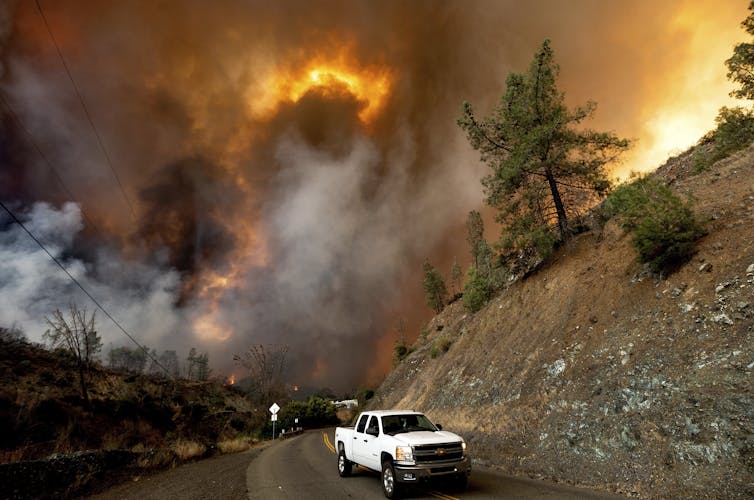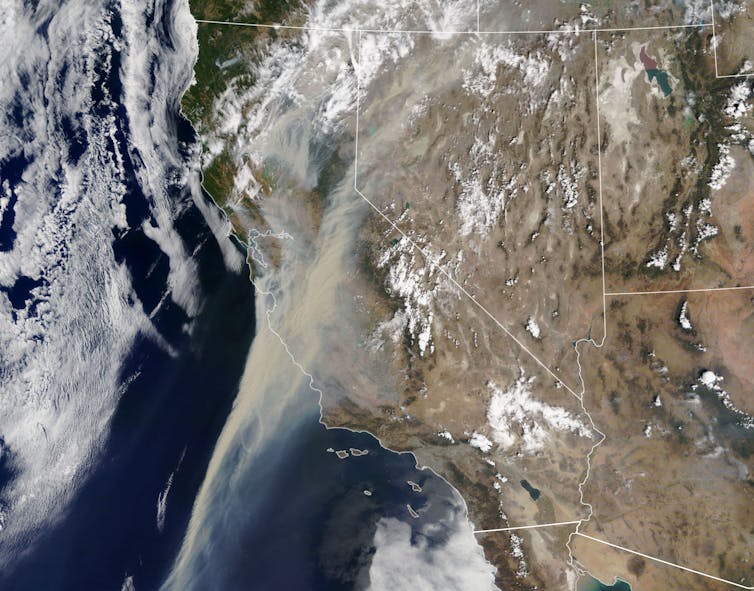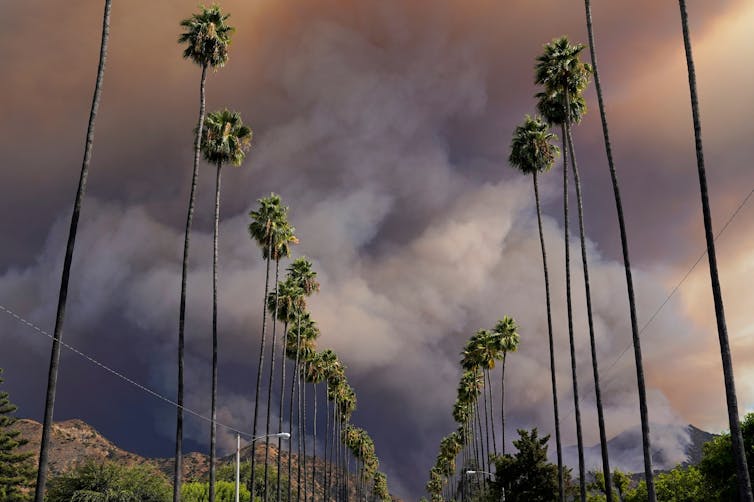
Experts in autocracies have pointed out that it is, unfortunately, easy to slip into normalizing the tyrant, hence it is important to hang on to outrage. These incidents which seem to call for the efforts of the Greek Furies (Erinyes) to come and deal with them will, I hope, help with that. As a reminder, though no one really knows how many there were supposed to be, the three names we have are Alecto, Megaera, and Tisiphone. These roughly translate as “unceasing,” “grudging,” and “vengeful destruction.”
Not everywhere in the United States is experiencing wildfires this year – yet. But just because you cannot see it or even smell it does not mean it is not dangerous to you – and I don’t mean just indirectly. We need to be aware as much as we can.
================================================================
What’s in wildfire smoke, and why is it so bad for your lungs?

AP Photos/Noah Berger
Luke Montrose, Boise State University
If I dare to give the coronavirus credit for anything, I would say it has made people more conscious of the air they breathe.
A friend texted me recently after going for a jog in the foothills near Boise, Idaho, writing: “My lungs are burning … explain what’s happening!!!”
A wildfire was burning to the east of town – one of hundreds of fires that were sending smoke and ash through communities in hot, dry western states. As an environmental toxicologist, I research how air pollution, particularly wood smoke, impacts human health and disease.
I gave my friend the short answer: The state had issued a yellow, or moderate, air quality index warning due in part to wildfires. The high temperature for the day was expected to reach 100 degrees Fahrenheit, and it was already approaching 90. That combination of high temperatures and elevated levels of particles from a fire can affect even healthy lungs. For someone with lung damage or respiratory illness, moderate levels of smoke particulate can exacerbate respiratory problems.
That’s only the start of the story of how wildfire smoke affects humans who breathe it. The rest, and how to stay healthy, is important to understand as the western wildfire season picks up.
What’s in wildfire smoke?
What exactly is in a wildfire’s smoke depends on a few key things: what’s burning – grass, brush or trees; the temperature – is it flaming or just smoldering; and the distance between the person breathing the smoke and the fire producing it.
The distance affects the ability of smoke to “age,” meaning to be acted upon by the sun and other chemicals in the air as it travels. Aging can make it more toxic. Importantly, large particles like what most people think of as ash do not typically travel that far from the fire, but small particles, or aerosols, can travel across continents.

Lauren Dauphin/NASA Earth Observatory
Smoke from wildfires contains thousands of individual compounds, including carbon monoxide, volatile organic compounds (VOCs), carbon dioxide, hydrocarbons and nitrogen oxides. The most prevalent pollutant by mass is particulate matter less than 2.5 micrometers in diameter, roughly 50 times smaller than a grain of sand. Its prevalence is one reason health authorities issue air quality warnings using PM2.5 as the metric.
What does that smoke do to human bodies?
There is another reason PM2.5 is used to make health recommendations: It defines the cutoff for particles that can travel deep into the lungs and cause the most damage.
The human body is equipped with natural defense mechanisms against particles bigger than PM2.5. As I tell my students, if you have ever coughed up phlegm or blown your nose after being around a campfire and discovered black or brown mucus in the tissue, you have witnessed these mechanisms firsthand.
The really small particles bypass these defenses and disturb the air sacks where oxygen crosses over into the blood. Fortunately, we have specialized immune cells present in the air sacks called macrophages. It’s their job to seek out foreign material and remove or destroy it. However, studies have shown that repeated exposure to elevated levels of wood smoke can suppress macrophages, leading to increases in lung inflammation.
What does that mean for COVID-19 symptoms?
Dose, frequency and duration are important when it comes to smoke exposure. Short-term exposure can irritate the eyes and throat. Long-term exposure to wildfire smoke over days or weeks, or breathing in heavy smoke, can raise the risk of lung damage and may also contribute to cardiovascular problems. Considering that it is the macrophage’s job to remove foreign material – including smoke particles and pathogens – it is reasonable to make a connection between smoke exposure and risk of viral infection.
Recent evidence suggests that long-term exposure to PM2.5 may make the coronavirus more deadly. A nationwide study found that even a small increase in PM2.5 from one U.S. county to the next was associated with a large increase in the death rate from COVID-19.

AP Images/Marcio Jose Sanchez
What can you do to stay healthy?
The advice I gave my friend who had been running while smoke was in the air applies to just about anyone downwind from a wildfire.
Stay informed about air quality by identifying local resources for air quality alerts, information about active fires, and recommendations for better health practices.
If possible, avoid being outside or doing strenuous activity, like running or cycling, when there is an air quality warning for your area.
Be aware that not all face masks protect against smoke particles. In the context of COVID-19, the best data currently suggests that a cloth mask benefits public health, especially for those around the mask wearer, but also to some extent for the person wearing the mask. However, most cloth masks will not capture small wood smoke particles. That requires an N95 mask in conjunction with fit testing for the mask and training in how to wear it. Without a proper fit, N95s do not work as well.
[Deep knowledge, daily. Sign up for The Conversation’s newsletter.]
Establish a clean space. Some communities in western states have offered “clean spaces” programs that help people take refuge in buildings with clean air and air conditioning. However, during the pandemic, being in an enclosed space with others can create other health risks. At home, a person can create clean and cool spaces using a window air conditioner and a portable air purifier.
The EPA also advises people to avoid anything that contributes to indoor air pollutants. That includes vacuuming that can stir up pollutants, as well as burning candles, firing up gas stoves and smoking.![]()
Luke Montrose, Assistant Professor of Community and Environmental Health, Boise State University
This article is republished from The Conversation under a Creative Commons license. Read the original article.
================================================================
Alecto, Megaera, and Tisiphone, “can travel across continents” – I suppose there are things scarier than that, but not many, and not much. Although “can suppress macrophages” is also right up there. At least this article gives us some practical, personal advice on avoiding as much damage as possible – and you can’t do it for us; we must practice it ourselves. I think the best thing you can do for us at this point is to help inspire people to VOTE, and specifically to VOTE BLUE, no matter who, top to bottom. And then hang around for the fights which are certain to come, and help us prevail. Only then will we be able to start the real battle to prevent the end of the world as we know it.
The Furies and I will be back.
7 Responses to “Everyday Erinyes #232”
Sorry, the comment form is closed at this time.

Thanks JD!
I’ve been having some respiratory issues, even though the air I breathe is filtered. Diana told me that helps, but it does not get it all. She said all her patients have respiratory issues due to the smoke. At least I can see downtown today.
I’ll not ever forget the 2011 wildfires here, in my lil town. Sep 4, 2011 … a large number of acres burned. Every year we go through a drought, with everything drying up and becoming brittle, with everyone being nervous about the conditions.
It is frightening, to say the least, and yes, lung damage is real and dangerous, as much as the fire and the smoke itself blowing into the sky. The air quality is harmful to the body, re: the cardio and respiratory health. That’s not including the covid-19 pandemic.
California, Oregon, and Washington state are fighting their fires, read that 2.2 million acres have burned. (probably more now).
The damage done to humans, the environment, and animals/wildlife is heartbreaking, and will have effects for years to come, and will continue until we do something about this.
Climate change is real, and will get worse as these fires react to the weather changes, and with folks not listening or caring about Mother Nature in all her warnings.
Thanks, Joanne for the information and posting.
Great article, Joanne.
Appreciate your complete explanation about how the wildfires/smoke issues affect our environment and our health.
Here in San Diego, we’ve been suffering with the smoke and ash that has been from the northern fires for over two weeks. The sky has been darken by the smoke/ash in the air. All around the home you can see the ash.
I personally haven’t been going outside that often due to Covid-19 and now with these fires/smoke filled skies, I’ve been staying in even more.
We’ve suffered with high heat and humidity which doesn’t help the matter. For the past few years I’ve noticed that we’ve had higher temperatures that last longer. I feel that it’s Mother Nature’s way of letting us know that Climate change is happening now. It’s too bad that we have a leader who calls it Fake news. Just last week he sat with our California Governor, Fire Captain, Forest Captain and just brushed it off, saying it was because of the dry leaves that cause fires.
Scares me that it’s not going to get better, till we get a leader in there who will take Climate Change seriously. That goes for taking Covid-19 seriously too. One that will do more to protect us and our environment.
Thanks again, Joanne
A good find!
Thanks Joanne. Good explanation of the key risk elements. A couple days ago the AirNow (EPA’s national website for air quality index data where you drill down to state and county) changed with an explanation they were using adjusted measures from what some air quality districts used (because more sensors more frequently updated that are more useful for smoke blowing through)–a change that reduced the number of measures available so the ones with predictive value for where I live are now gone (what I was using 30 to 15 years ago had even more local to me measures and took into account an ozone anomaly affecting my ridge line)–so now we have nothing different for the elevations between sea level and over 3000 ft. level in my area.
Lost count of the number of people I know that developed asthma or changed to chronic asthma diagnoses starting with my area’s last major fire in 2014. The smoke here lasted a month and after clearing, smoke was returning 24 hrs. later–at the moderate level today with wind and smoke still from the fire to the south. We may yet get smoke from the one to the north, too, since winds up there are from the north.
Hardware stores carry a variety of particulate (nonsurgical) N95 masks (for sanding, allergies, etc.)–also seeing some KN95s which are the Korean version. A cloth mask can be worn over it when going places in public for protecting from both smoke and COVID-19.
Sadly, this is all terribly familiar for us Aussies. The numbers of people affected by the smoke of the bushfires were only just coming out when they got buried in the COVID-19 frenzy, to the relief of our government.
A quote from back then (May 2020) and reminding you that Australia only has a population of 26 million:
So your excellent article of warning is very timely, especially now the effects of the inhalation of smoke particles seem to have detrimental effects on COVID-19 patients. Thank you.
thanks.